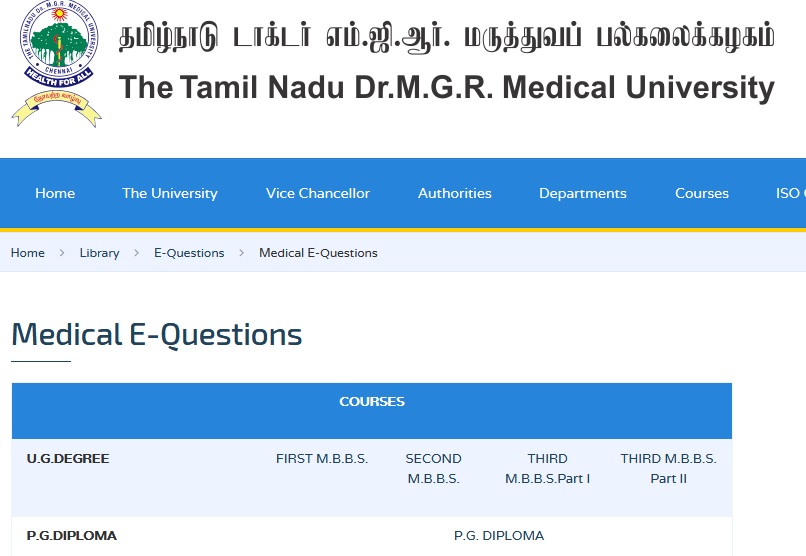Epidemiological Methods in Health Management M.Sc Non Medical Question Bank : web.tnmgrmu.ac.in
Name of the University : The Tamilnadu Dr. M.G.R. Medical University
Degree : M.Sc Non Medical Degree Examination
Subject Code/Name : 3003/Epidemiological Methods in Health Management
Paper : III
Document Type : Question Bank
Website : web.tnmgrmu.ac.in
Download Model/Sample Question Paper :
1991-2000 : https://www.pdfquestion.in/uploads/web.tnmgrmu.ac.in/4072-1-313003KC.pdf
2001-2013 : https://www.pdfquestion.in/uploads/web.tnmgrmu.ac.in/4072-2-313003KX.pdf
TNMGRMU Epidemiological Methods in Health Management Question Paper
[KY 236]
Sub. Code: 3003
M.Sc. (EPIDEMIOLOGY) DEGREE EXAMINATION.
Part I :
Paper III : EPIDEMIOLOGICAL METHODS IN HEALTH MANAGEMENT
Q.P. Code : 313003
Time : Three hours
Maximum : 100 marks
Related : TNMGRMU Research Methodology & Epidemiological Analysis M.Sc Non Medical Question Bank : www.pdfquestion.in/3999.html
MAY 2011
Answer All questions. :
I. Elaborate on : (2 x 20 = 40)
1. You are the epidemiologist of a district. How will you quantity the problem of malaria in the district, to enable planning of control measures.
2. Discuss epidemiologic transition in India.
II. Write notes on : (10 x 6 = 60)
1. Discuss the essential variable required to study the natural history of diabetes mellitus in a community.
2. Discuss scenario where high positive predictive value and high negative predictive values are useful.
3. What are the statistical methods available to identify interaction between variables in a study?

4. Give an example where retrospective Cohort study can be used.
5. In a study of “respiratory illness”, what factors can cause selection bias?
6. Design a study to evaluate the effectiveness of “Modified leprosy Elimination Campaign” in control of leprosy.
7. Describe statistical analysis that can be used to analyse relationship between presence or absence of “distinction score” in the subject and the duration of lectures attended.
8. Differentiate time calculation while estimating “Cumulative incidence” and “Survival analysis”.
9. Registration of vital events act 2000.
10. Costing “Road traffic accidents”.
October 2011
Answer ALL questions in the same order. :
I. Elaborate on :
1. How will you assess “functional status” in evaluating health as per the WHO guidelines?
2. How will you estimate the fertility of a region?
II. Write notes on :
1. Describe the variables required to study the spectrum of disease of Vitamin A deficiency.
2. Advantages and limitations of using parallel and serial screening tests.
3. Discuss confounding effect in a study and methods to overcome this.
4. Advantages and limitations of nested case control study.
5. In a study on efficacy of “Coaching class” in scoring marks discuss the need for comparison group.
6. Differentiate screening and case finding under the Revised National Tuberculosis Control Programme.
7. Prevalence of smoking in Chennai is 10% with 95% confidence interval of 0.1 to 19.9%. Discuss the meaning conveyed by this statement.
8. How can sampling error be estimated?
9. Dependency ratio – its implications.
10. Cost utility analysis of “Quarterly family picnic programme” in improving work output.
October 2012
Sub. Code: 3003
I. Elaborate on:
1. How will you assess “functional status” in evaluating health as per the WHO guidelines?
2. How will you estimate the fertility of a region?
II. Write notes on:
1. Describe the variables required to study the spectrum of disease of Vitamin A deficiency.
2. Advantages and limitations of using parallel and serial screening tests.
3. Discuss confounding effect in a study and methods to overcome this.
4. Advantages and limitations of nested case control study.
5. In a study on efficacy of “Coaching class” in scoring marks discuss the need for comparison group.
6. Differentiate screening and case finding under the Revised National Tuberculosis Control Programme.
7. Prevalence of smoking in Chennai is 10% with 95% confidence interval of 0.1 to 19.9%. Discuss the meaning conveyed by this statement.
8. How can sampling error be estimated?
9. Dependency ratio – its implications.
10.Cost utility analysis of “Quarterly family picnic programme” in improving work output.
October 2013
Answer ALL questions in the same order. :
I. Elaborate on :
1. Discuss the Epidemiological determinants of type 2 Diabetes mellitus? Briefly explain about screening in Diabetes?
2. Classify Epidemiological studies? Explain in detail the design and steps in conducting a Randomized controlled trial?
II. Write Notes on :
1. Proportional mortality rate.
2. Receiver operating curve.
3. Measurement of validity of a screening test.
4. Sampling methods.
5. Herd immunity.
6. HIV surveillance.
7. Assessment of Obesity.
8. Demographic gap.
9. Cultural factors in disease causation.
10. Prevention and control of air pollution.